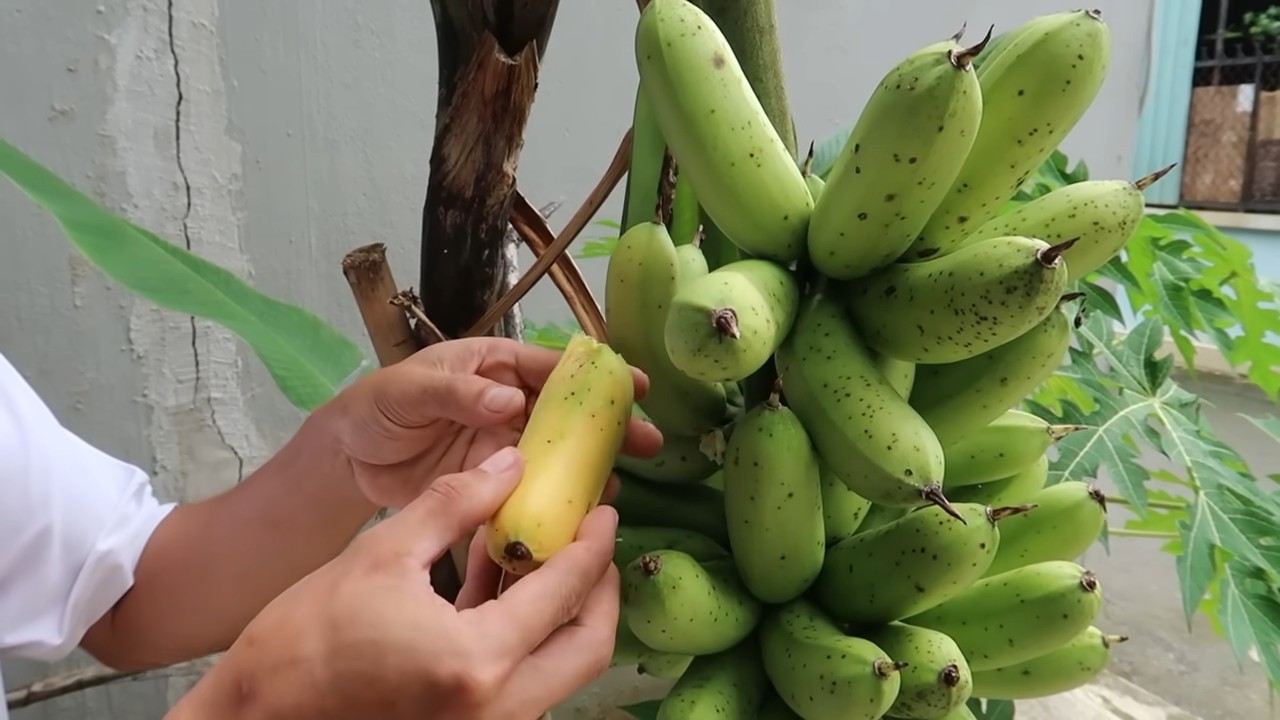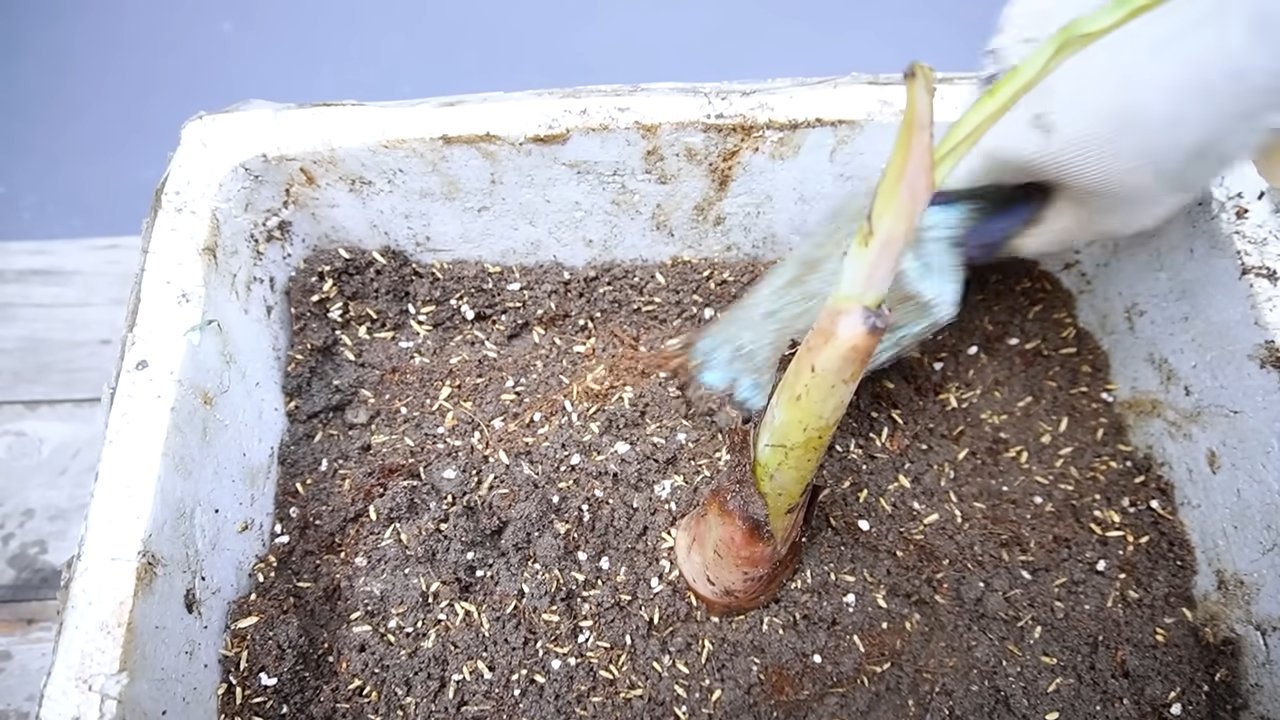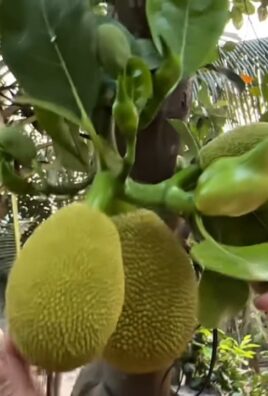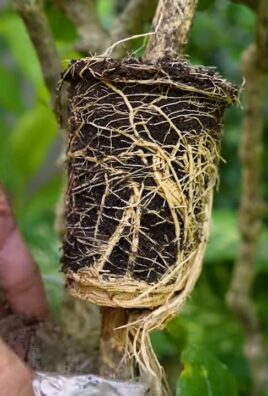Growing bananas at home might sound like a tropical dream reserved for exotic locales, but I’m here to tell you it’s more achievable than you think! Forget expensive imported fruit; imagine stepping into your backyard and harvesting your own sweet, creamy bananas.
For centuries, bananas have been a staple food and a symbol of abundance in many cultures, from Southeast Asia to South America. Their cultivation dates back thousands of years, and now, thanks to innovative techniques, you can bring a piece of that history to your own garden.
Why should you embark on this DIY adventure? Well, beyond the sheer satisfaction of nurturing your own food source, growing bananas at home offers a fantastic opportunity to connect with nature, reduce your carbon footprint, and enjoy the freshest, most flavorful bananas imaginable. Plus, it’s a fun and rewarding project for the whole family! This article will guide you through simple, effective DIY tricks and hacks that will transform your backyard into a mini-banana plantation. Get ready to unleash your inner gardener and enjoy the sweet taste of success!

Growing Bananas at Home: A DIY Guide to Tropical Delights
Hey there, fellow plant enthusiasts! Ever dreamt of harvesting your own bananas right in your backyard? It might sound like a tropical fantasy, but trust me, with a little know-how and a dash of patience, you can absolutely grow bananas at home! I’m going to walk you through everything you need to know, from choosing the right variety to harvesting your delicious, homegrown fruit. Let’s get started!
Choosing the Right Banana Variety
First things first, not all banana varieties are created equal, especially when it comes to growing them in a non-tropical climate. You’ll want to choose a variety that’s well-suited to your local conditions and the space you have available. Here’s a breakdown of some popular choices:
* Dwarf Cavendish: This is a classic choice for home growers. It’s relatively compact, reaching only 6-10 feet tall, making it perfect for smaller gardens or even container growing. The fruit is sweet and delicious, just like the ones you find in the store.
* Rajapuri: Another excellent dwarf variety, Rajapuri bananas are known for their cold hardiness and sweet, creamy fruit. They typically grow to about 5-7 feet tall.
* Ice Cream (Blue Java): If you’re feeling adventurous, try growing Ice Cream bananas! These unique bananas have a distinct vanilla flavor and a slightly blue tint to the unripe fruit. They’re moderately cold-hardy and grow to about 10-15 feet.
* Orinoco: This variety is known for its exceptional cold tolerance. The bananas are shorter and plumper than Cavendish, with a slightly tangy flavor. They grow to about 10-12 feet.
* Goldfinger: A relatively new variety, Goldfinger bananas are disease-resistant and produce sweet, slightly tangy fruit. They grow to about 8-10 feet.
Important Considerations:
* Climate: Research the cold hardiness of each variety and choose one that can withstand the lowest temperatures in your area. If you live in a colder climate, consider growing your banana plant in a container so you can bring it indoors during the winter.
* Space: Banana plants can get quite large, so make sure you have enough space for them to grow. Dwarf varieties are a good option for smaller gardens or containers.
* Taste Preference: Consider the flavor profile of each variety and choose one that you’ll enjoy eating.
Preparing the Planting Site
Bananas are heavy feeders, so preparing the planting site properly is crucial for their success. Here’s what you need to do:
* Sunlight: Bananas need at least 6-8 hours of direct sunlight per day. Choose a location that gets plenty of sun.
* Soil: Bananas prefer well-draining, fertile soil that’s rich in organic matter. Amend your soil with compost, aged manure, or other organic materials to improve its fertility and drainage.
* Drainage: Poor drainage can lead to root rot, which is a common problem for banana plants. Make sure your soil drains well. If you have heavy clay soil, consider planting your banana plant in a raised bed or container.
* Wind Protection: Banana leaves are large and easily damaged by strong winds. Choose a location that’s sheltered from strong winds, or provide some wind protection with a fence or other structure.
Planting Your Banana Plant
Now that you’ve chosen your variety and prepared the planting site, it’s time to plant your banana plant!
1. Dig a Hole: Dig a hole that’s twice as wide and as deep as the root ball of your banana plant.
2. Amend the Soil: Mix some compost or other organic matter into the soil you removed from the hole.
3. Plant the Banana Plant: Carefully remove the banana plant from its container and gently loosen the roots. Place the plant in the hole, making sure the top of the root ball is level with the surrounding soil.
4. Backfill the Hole: Backfill the hole with the amended soil, gently firming it around the roots.
5. Water Thoroughly: Water the banana plant thoroughly after planting.
6. Mulch: Apply a layer of mulch around the base of the plant to help retain moisture and suppress weeds.
Caring for Your Banana Plant
Once your banana plant is planted, it’s important to provide it with the proper care to ensure its health and productivity.
* Watering: Bananas need plenty of water, especially during the growing season. Water deeply and regularly, keeping the soil consistently moist but not waterlogged. Reduce watering during the winter months.
* Fertilizing: Bananas are heavy feeders and need regular fertilization to produce healthy growth and abundant fruit. Use a balanced fertilizer that’s high in potassium. Fertilize every 2-3 months during the growing season.
* Pruning: Remove any dead or damaged leaves regularly. You can also remove suckers (small shoots that grow from the base of the plant) to encourage the main plant to focus its energy on fruit production. However, leaving one or two suckers can help ensure a continuous supply of bananas in the future.
* Pest and Disease Control: Bananas are relatively pest-resistant, but they can be susceptible to certain pests and diseases, such as aphids, spider mites, and fungal infections. Inspect your plant regularly for signs of pests or diseases and take appropriate action if necessary. Insecticidal soap or neem oil can be effective for controlling many common pests. For fungal diseases, use a fungicide according to the manufacturer’s instructions.
Protecting Your Banana Plant from Cold Weather
If you live in a climate with cold winters, you’ll need to protect your banana plant from frost and freezing temperatures. Here are a few options:
* Container Growing: If you’re growing your banana plant in a container, you can simply bring it indoors during the winter. Place it in a sunny location and water it sparingly.
* Mulching: Apply a thick layer of mulch around the base of the plant to insulate the roots.
* Wrapping: Wrap the trunk and leaves of the plant with burlap or frost cloth to protect them from frost.
* Building a Frame: Build a frame around the plant and cover it with plastic sheeting to create a mini-greenhouse.
Harvesting Your Bananas
After several months of care, your banana plant will eventually produce a flower stalk, which will develop into a bunch of bananas. Here’s how to know when your bananas are ready to harvest:
1. Check the Shape: The bananas will become plumper and more rounded as they ripen.
2. Check the Color: The bananas will change color from green to yellow, depending on the variety.
3. Check the Feel: The bananas will feel slightly softer to the touch.
Once the bananas are ripe, you can harvest the entire bunch by cutting the stalk with a sharp knife. Hang the bunch in a cool, dry place to allow the bananas to ripen fully.
Ripening Tips:
* To speed up the ripening process, place the bananas in a paper bag with an apple or a banana.
* To slow down the ripening process, store the bananas in the refrigerator.
Enjoying Your Homegrown Bananas
Congratulations! You’ve successfully grown your own bananas at home! Now it’s time to enjoy the fruits of your labor. Eat them fresh, use them in smoothies, bake them into bread, or make banana pudding. The possibilities are endless!
Growing bananas at home can be a rewarding experience. With a little bit of effort, you can enjoy fresh, delicious bananas right from your own backyard. Happy gardening!

Conclusion
So, there you have it! Growing bananas at home might seem like a tropical dream reserved for those living in equatorial paradises, but with a little know-how and dedication, it’s an achievable reality for many. This DIY trick, focusing on creating the optimal microclimate and providing the necessary nutrients, is a game-changer for banana enthusiasts residing outside of traditional banana-growing zones. It’s not just about having a banana plant; it’s about nurturing it to the point where it rewards you with its sweet, creamy fruit.
Why is this DIY trick a must-try? Because it empowers you to take control of your banana plant’s environment. Instead of passively hoping for the best, you’re actively creating the conditions it needs to thrive. This method addresses the two biggest challenges faced by home banana growers: temperature fluctuations and nutrient deficiencies. By utilizing simple techniques like mulching, strategic placement, and homemade fertilizer blends, you can significantly increase your chances of a successful harvest.
Beyond the satisfaction of growing your own food, this DIY project offers a unique connection to nature. Watching your banana plant unfurl its majestic leaves, witnessing the emergence of the flower stalk, and finally, harvesting your own homegrown bananas is an incredibly rewarding experience. It’s a testament to your patience, dedication, and understanding of the natural world.
Looking for variations? Consider experimenting with different types of organic matter for your mulch. Coffee grounds, shredded leaves, and even composted kitchen scraps can all contribute valuable nutrients to the soil. You can also tailor your fertilizer blend to the specific needs of your banana plant at different stages of its growth. For example, a fertilizer higher in nitrogen might be beneficial during the vegetative stage, while a fertilizer richer in potassium could promote fruit development. Another variation is to explore different banana varieties suited to your climate. Some dwarf varieties are particularly well-suited for container growing and can even be brought indoors during the colder months.
We wholeheartedly encourage you to try this DIY trick for growing bananas at home. Don’t be intimidated by the perceived complexity. Start small, be patient, and learn from your experiences. The journey is just as rewarding as the destination. And most importantly, share your experiences with us! We’d love to hear about your successes, your challenges, and any modifications you make to the method. Your feedback will help us refine this guide and empower even more people to enjoy the fruits (literally!) of their labor. Let’s build a community of home banana growers and spread the joy of this tropical delight!
FAQ
Frequently Asked Questions About Growing Bananas at Home
Q: What type of banana plant is best for growing at home?
A: The best type of banana plant for growing at home depends largely on your climate and available space. Dwarf varieties, such as Dwarf Cavendish or Rajapuri, are excellent choices for container growing and are more tolerant of cooler temperatures. These varieties typically reach a height of 6-10 feet, making them manageable for smaller spaces. If you live in a warmer climate with ample space, you can consider larger varieties like Williams or Gros Michel. However, be aware that these can grow to 15-20 feet tall. Research the cold hardiness of each variety before making your selection to ensure it can withstand your local winter temperatures.
Q: How much sunlight does a banana plant need?
A: Banana plants thrive in full sun, requiring at least 6-8 hours of direct sunlight per day. Insufficient sunlight can lead to stunted growth, reduced fruit production, and pale leaves. If you’re growing your banana plant indoors or in a partially shaded area, consider supplementing with grow lights to ensure it receives adequate light. Rotate the plant regularly to ensure all sides receive even exposure.
Q: What kind of soil is best for banana plants?
A: Banana plants prefer well-draining, fertile soil that is rich in organic matter. A slightly acidic to neutral pH (6.0-7.0) is ideal. Amend your soil with compost, aged manure, or other organic materials to improve drainage, aeration, and nutrient content. Avoid heavy clay soils that retain too much water, as this can lead to root rot. A good potting mix for container-grown bananas consists of equal parts potting soil, peat moss, and perlite.
Q: How often should I water my banana plant?
A: Banana plants are heavy drinkers and require consistent moisture, especially during the growing season. Water deeply whenever the top inch of soil feels dry to the touch. Avoid overwatering, which can lead to root rot. Reduce watering frequency during the winter months when the plant’s growth slows down. Ensure that your container has adequate drainage holes to prevent waterlogging.
Q: What kind of fertilizer should I use for my banana plant?
A: Banana plants are heavy feeders and benefit from regular fertilization. Use a balanced fertilizer with a higher potassium content (e.g., 10-10-20) to promote fruit production. Fertilize every 2-3 weeks during the growing season (spring and summer). Reduce fertilization frequency during the winter months. You can also supplement with organic fertilizers such as compost tea, fish emulsion, or bone meal.
Q: How do I protect my banana plant from frost?
A: Banana plants are sensitive to frost and can be damaged or killed by freezing temperatures. If you live in an area with occasional frosts, take steps to protect your plant. For container-grown bananas, move the plant indoors to a warm, sunny location. For in-ground plants, wrap the trunk with burlap or blankets to insulate it from the cold. You can also create a temporary shelter around the plant using plastic sheeting or frost cloth. Mulching heavily around the base of the plant can also help protect the roots from freezing.
Q: How long does it take for a banana plant to produce fruit?
A: The time it takes for a banana plant to produce fruit depends on the variety, climate, and growing conditions. Generally, it takes 9-15 months from planting to harvest. The plant will first produce a flower stalk, followed by the development of small bananas. It takes several months for the bananas to mature and ripen.
Q: How do I know when my bananas are ripe?
A: Bananas are typically harvested when they are still green but have reached their full size. The ridges on the bananas will become more rounded, and the fruit will feel slightly softer to the touch. To ripen the bananas, cut the entire stalk from the plant and hang it in a cool, dry place. You can also place individual bananas in a paper bag with an apple or banana to speed up the ripening process.
Q: My banana plant has pups (suckers). Should I remove them?
A: Banana plants naturally produce pups, which are new shoots that emerge from the base of the plant. You can choose to remove the pups or allow them to grow. Removing the pups will direct more energy to the main plant, potentially resulting in larger fruit. However, allowing the pups to grow will create a clump of banana plants, which can provide more shade and wind protection. If you choose to remove the pups, do so carefully using a sharp knife or shovel. You can then transplant the pups to new locations to propagate more banana plants.
Q: What are some common pests and diseases that affect banana plants?
A: Banana plants can be susceptible to various pests and diseases, including aphids, spider mites, nematodes, and fungal infections. Regularly inspect your plant for signs of infestation or disease. Treat any problems promptly with appropriate insecticides, miticides, or fungicides. Good cultural practices, such as proper watering, fertilization, and sanitation, can help prevent many pest and disease problems.





Leave a Comment